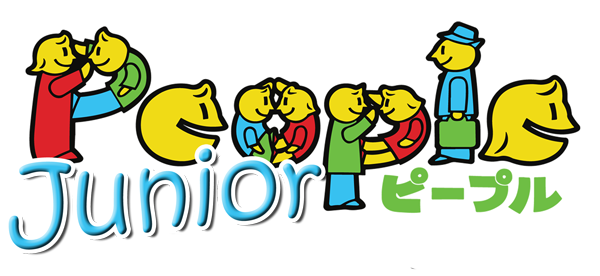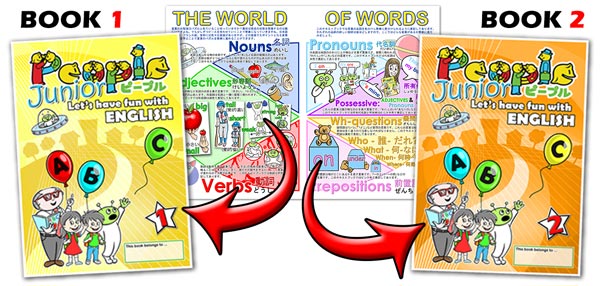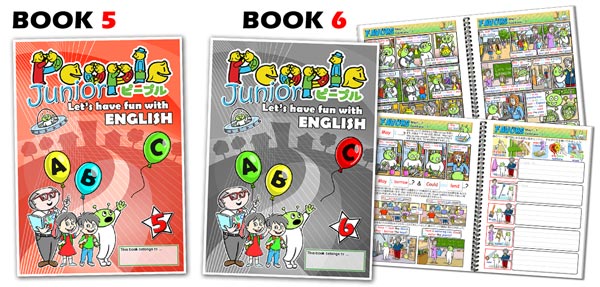People English
Book-Contents


TEXTBOOK CONTENTS

While both textbook 1 and 2 teach the concept of ‘The World of Words’, they have different vocabulary sets, Phonics Writting Pages and Word Cloud. Orange Book 2 is slightly more challenging with more questions about ‘plural nouns’ and ‘negative questions’. There are 8 Units in these books to complete in the year.
Book 1と2のテキストブックは、「The World of Words」のコンセプトを学習する内容となっていますが、収録されている語彙やPHONICSの書取り宿題、また Word Cloudの内容はそれぞれ異なります。Book2では、複数形や否定文の質問など、内容もよりチャレンジングになっています。テキストブックにはそれぞれ8つの単元が収録それており、これを一年かけて学習します。


- Introducing PRONOUNS – ‘I am…, He is…, They are…’
- ‘NOT’- Making negative sentences. – ‘She is not…’
- ‘YES/NO Questions’- Turning sentences into questions. – ‘Your are .. – Are you ..?’

- Introduction to ADJECTIVE SET 1 – ‘big, small, clean, dirty, etc.’ x 14
- Describing the ‘CARS’ using adjectives, ‘It is dirty. It is not long.’
- Asking ‘YES/NO Questions’ about the ‘CARS’ – ‘Is it fast?’
- Adjective Glossary and quiz- COLORS and FEELINGS.
- Adjective Glossary and quiz- WEATHER & ADJECTIVE SET 2 (Preview)

- Introduction to VERBS- VERBS & ‘-ing’, ‘They are dancing.’
- VERBS & NOUNS – ‘She is drinking coffee.’
- ‘Do you …?’ – ‘Do you play golf?’, ‘Yes, I do.’ / ‘No, I do not.’
- Questions using ‘WHAT’- ‘What do you ..eat/drink/play…?’
- VERB GLOSSARY 1,2,3,4

- FRUITS- singular and plural nouns x12.
- ‘What is this? / What are these?’ – It is a (It’s) …. / They are (They’re) ……..s.
- THIS-THAT-THESE-THOSE- ‘What’s this/that?, What are these/those?’
- Forming sentences- ‘This/that is a… / These/those are…’

- Introducing PREPOSITIONS – ‘ in, on, under, next to, etc.’ x 8.
- ‘Where is the ..FRUIT…?’ , It is is ….under.. the table.
- Forming sentences- ‘The apple(s) is/are on the table.’
- Asking ‘YES/NO Questions’ – ‘Is the banana on the chair?’

- Introducing OCCUPATIONS – ‘doctor, nurse, carpenter, farmer, etc.’ x 12
- ‘WH’-Questions – ‘Who is/are he/she/they?’, ‘He is a ..doctor..’
- VERBS- ‘Who is she? What is she doing?’, ‘She is VERB-ing.
- ‘WH’-Questions – ‘Who? What? Who with?’

- NOUNS- Fruits, Drinks, Animals, Colors, Stationary x 60
- like/don’t like – Do you like…?- ‘Yes, I do./ No, I don’t.’
- What ..NOUN.. do you like? ‘What fruit do/don’t you like?’
- The 3rd Person VERB- The ‘S’ Rule – ‘He likes apples.’ (Preview)

- Can/Can’t – Animals and their abilities.
- ‘It can …swim…’, ‘It can’t climb a tree.’
- ‘Can it ..swim..?’, ‘Yes, it can. No, it can’t.’
- ‘WH’-Questions- ‘What can you do?’, ‘I can …’


- Introducing PRONOUNS – ‘I am…, He is…, They are…’
- ‘NOT’- Making negative sentences- ‘They are not…’
- ‘YES/NO Questions’- Turning sentences into questions. – ‘Your are .. – Are you ..?’

- Introduction to ADJECTIVE SET 2 – ‘tall, short, kind, mean, etc.’ x 14
- Describing the ‘ALIENS’ using adjectives, ‘She is kind. She is not tall.’
- Asking ‘YES/NO Questions’ about the ‘ALIENS’ – ‘Is she tall?’
- Adjective Glossary and quiz- COLORS and FEELINGS.
- Adjective Glossary and quiz- WEATHER & ADJECTIVES 1 (Review)

- Introduction to VERBS- VERBS & ‘-ing’, ‘They are camping.’
- VERBS & NOUNS – ‘He is eating cake.’
- ‘Do you …?’ – ‘Do you drink coffee?’, ‘Yes, I do.’ / ‘No, I do not, (don’t).’
- Questions using ‘WHAT’- “What do/don’t you ..study/draw/watch…?
- VERB GLOSSARY 1,2,3,4

- CLASSROOM ITEMS- singular and plural nouns x 12
- ‘What is this? / What are these?’ – It is a (It’s) …. / They are (They’re) ……..s.
- THIS-THAT-THESE-THOSE- ‘What’s this/that?, What are these/those?’
- Sentences & Asking questions- ‘Is this/that a …?’, ‘Are these/those…?’

- Introducing PREPOSITIONS – ‘ in, on, under, next to, etc.’ x 8.
- ‘Where is/are the …CLASSROOM ITEMS..?’ , It is/ They are …on… the chair.
- Forming sentences- ‘The book(s) is/are next to the bucket.’
- Asking ‘YES/NO Questions’- ‘Is/Are the pencil(s)on the chair?’

- Introducing PLACES – ‘park, bank, school, etc.’ x 12
- WH Questions – ‘Where is/are he/she/they going?’, ‘She is going to the park.’
- VERBS- ‘What is he doing? Where is he going?’
- WH Questions- ‘What? Where? Who with?’

- LIKE-WANT-HAVE- What do they mean?
- Do you like/want/have..?- ‘Yes, I do./ No, I don’t.’
- What ..NOUN.. do/don’t you ..VERB..? ‘What color do/don’t you like?’
- The 3rd Person VERB- The ‘S’ Rule – ‘She plays piano.’ (Preview)

- Introduction to FEELINGS – ‘happy, sad, hot, cold, etc.’
- ‘He is…, She is …’, They are …’
- Asking Questions- ‘How are you?, How is she?’
- YES/NO Questions- ‘Is she…? Are they…?’

Books 3 and 4 become more challenging. After completing the CORE BASICS, students continue to learn how to build sentences and ask and answer questions. There are 6 units in these books but they are longer units. More vocabulary is introduced and different verb tenses are explored.
Book 3と4では、内容もさらに難しくなります。CORE BASICSと呼ばれる復習期間の後に、文の構成のしかたを学習し、質問をしたり、また質問に答えられるよう練習をします。Book 3と4は、それぞれ6つの単元が収録されています。単元数はBook 1と2に比べると少ないですが、それぞれの単元が長くなり、より深く学習することができます。これらのテキストブックでは、より多くの語彙を増やし、また動詞の時制を学習します。


- Introduction to the ‘S-Rule’: adding an ‘S’ to verbs in the Simple Present tense.
- ‘He like bananas.’ or ‘He likes bananas.’: when to add the ‘S’.
- ‘What does he/she eat/ drink/ play/ watch?’
- DAYS of the WEEK + ‘on’: ‘What does he/she do on ..Monday..?’, She plays tennis on Monday. ‘When does he/she…?’, She studies English on Tuesday.’

- Introduction to the various uses of the word, ‘have’ and ‘has’, (The S-Rule).
- ADJECTIVES & PARTS of the BODY: Describing a robot; ‘It has scary eyes.’
- ‘YES/NO-Questions’ using, ‘Does it…?’; ‘Does it have a yellow nose?’
- Describing a robot: ‘Whose robot is this?’

- ANIMALS: appearance and abilities.
- ANIMAL-ADJECTIVES: ‘It is fast, hairy and big.’ ‘Is it cute?’
- ‘Can it…?’: Asking questions about an animal’s abilities, ‘Can it ..climb a tree..?’
- An introduction to comparatives: ‘Which one is bigger?’, ‘A panda is cuter than a frog.’

- ‘will …’: talking about the future; ‘What will you do tonight?’
- FEELINGS and ACTIONS: ‘He is hungry. He will buy a snack.’
- TIME + ‘at’ : ‘What will he/she do at ..3 o’clock?’, ‘When will he/she …?’
- ‘WH-Questions’: ‘What will..?, When will…? and ‘Who will … with?’

- FAMILY MEMBERS – The present continuous tense -‘What is your father doing?’
- Follow-Up Questions – ‘What is he doing?’, ‘He is eating.’ ‘What is he eating?’
- COLORS & CLOTHES – What is her father wearing? He is wearing a blue shirt.
- That-That-These-Those – ‘Whose socks are these?’, ‘Those are her father’s socks.’

- Introduction to the Simple Past tense; regular & irregular verbs.
- ‘What did he/she do?’, He/She .. ate/ drank/ played.’
- ‘What did he/she eat/ drink/ play?’, He/She .. ate/ drank/ played ………..’
- ‘WH’- QUESTIONS, MONTHS + ‘in’ & PLACES: ‘Where did he go in July?’, ‘What did he do in September?, When did he go to the park? Who did he … with?


- Introduction to ‘was’ and ‘were’.
- WEATHER, FEELINGS & DAYS of the WEEK: ‘How was the weather on …Monday…?’
- TIME & ANIMALS: ‘What was it at …10 o’clock…?’, It was a snake at 10 o’clock.
- MONTHS & PREPOSITIONS: ‘Where was it in …January…?’, ‘Was it ….under the table.. in March?’

- PLACES: ‘Where is he..?; ‘He is at the park.’ ‘Where was he?’, ‘He was at the pool.’
- TIME: ‘What is he doing?’; What was he doing at ..3 o’clock..?’
- PLACES 2- ‘farm, airport, etc.’ – ‘will …’ vs. ‘..-ing’: ‘Where is he going/will he go?
- REASONS: ‘Why is he …?, ‘He is going to the ..cinema.. to ..watch a movie..’

- ADJECTIVES: Introduction to SUPERLATIVES; big, bigger, biggest.
- Comparing: ‘What’s the difference between a cat and a horse?’
- ‘Who’ vs. ‘Whose’: ‘Who has the longest legs?; ‘Whose legs are the longest?’
- ‘too ……’ & ‘not …… enough’: ‘The eyes are too big.’ ‘The ears are not long enough.’

- HOUSEHOLD ITEMS: plural and singular nouns.
- ‘There is/was a …’, ‘There are/were some …’
- ROOMS of the HOUSE: ‘There is a T.V. in the bedroom.’
- ‘How many? How much?’: Counting uncountable items.

- Introduction to ‘going to …’ : talking about future plans.
- CHORES, HOUSEHOLD ITEMS & FAMILY MEMBERS: ‘What will his ..mother.. do?’
- PARTS of the DAY: ‘What is ..her father.. going to do in the ..morning/ evening?’
- ‘WH’-QUESTIONS: ‘What/ When/ Where & Who with ..is he going to ……?’

- Simple Past Tense: More regular & irregular verbs.
- ‘What did he/she cook/clean/make?’, He /She .. cooked/cleaned/made ……’
- PLACES 3 – ‘beach, forest etc.’ & SEASONS: ‘Where/ When did he/she go ……?’
- ‘WH’-QUESTIONS, MONTHS & PLACES: ‘What/ When/ Where & Who with.. did he..?

Books 5 and 6 are the most challenging . The 6 units are longer again with bigger readings. After completing the CORE BASICS, which now includes keys points from books 3 and 4, the students continue to learn how to build longer sentences, ask and answer questions, give reasons and expand their knowledge of English grammar and tenses.
Book 5 と 6は、より高度な内容となっています。それぞれの単元は6つですが、これらもそれぞれの単元が長く、またリーディングの量も増大されています。CORE BASICSと呼ばれる復習にはBook 3と4で学習したキーポイントが含まれ、これから学習するより長い文を構成する準備をします。復習後は単元ごとに、より長い文の構成方法や質疑応答を学習するだけでなく、自己の考えや意思を伝える練習をし、時制など英文法の知識をより深めます。


- Introduction to adverbs of frequency, ‘always, sometimes, never’, etc.
- ‘Daily VERBS’; wake up, get dressed, brush your teeth, etc.
- ‘WH-Questions’: ‘What/ When/ Where does he/she usually …eat/ do/ go..?
- How often do you, does he/she ….? He … once a week, Twice a year etc.

- ‘Chores’ vs. ‘Hobbies’: ‘like to ..’, ‘want to ..’, ‘have to …’ + (The S-Rule)
- ‘Likes’ and ‘Dislikes’. Joining sentences with ‘AND’ and ‘BUT.’
- ‘Want to ..’: Giving reasons using ; ‘SO’ and ‘BECAUSE’.
- ‘Have to…’, ‘Don’t have to ..’, ‘Must…’, ‘Must not…’ : Rules and Obligations

- Levels of politeness, ‘Can I/you … please?’, ‘Could you…?’ and ‘May I …?’
- Asking favors and making excuses: ’Could you …?, I’m sorry, I have to …’
- ‘May I borrow…?’or ‘Could you lend ….?’; ‘Chores’ and ‘Tools’.
- ‘When I was … I could?’, ‘What could you do when your were 5?’










